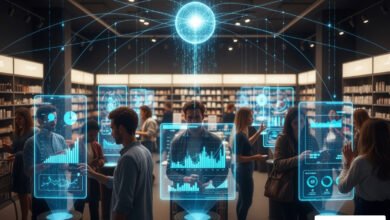The Top Benefits of Implementing AI Agents in Your Enterprise’s Workflow

Enterprises across sectors have automated their operations for decades, but traditional automation reached its limits. RPA and chatbots handle repetitive actions, yet they lack judgment, adaptability, and context. Today’s enterprise demands more than efficiency; it needs autonomy, intelligence, and scale.
That’s where AI agents for enterprises come in, self-learning, adaptive digital workers designed to think and act like human colleagues. They interpret data, reason across systems, and collaborate with teams to achieve business outcomes.
Unlike legacy bots, these agents evolve with the enterprise, turning static workflows into living systems that learn and optimize themselves over time.
Rethinking Enterprise Productivity with AI Agents
Enterprises are shifting from automation-as-a-tool to automation-as-a-workforce. AI agents represent digital employees who operate within defined roles, handling claims, onboarding staff, building reports, or drafting contracts, but doing so with awareness and decision logic.
This shift moves the enterprise from isolated automation toward cognitive collaboration, where human judgment and machine intelligence reinforce each other.
From Tasks to Outcomes
AI agents don’t just complete instructions; they understand intent and measure success.
- In healthcare, an agent reviewing patient authorizations doesn’t just submit forms, it detects missing documentation and suggests corrections.
- In insurance, an agent processing claims cross-references policy data for fraud detection in real time.
- In legal services, a contract-analysis agent flags risky clauses based on precedent.
The outcome is not simply faster work, it’s work that improves itself, delivering better accuracy, compliance, and customer outcomes with each iteration.
Key Benefits of Implementing AI Agents
AI agents unlock measurable gains across efficiency, intelligence, compliance, and scalability. Their value compounds over time as they learn from every task and interaction.
1. Enhanced Process Autonomy
Traditional automation waits for a human trigger. AI agents initiate, decide, and execute autonomously. They process documents, handle exceptions, and escalate only when required.
For example, in fintech operations, an AI agent can monitor transaction flows and pause suspicious activity without human intervention. In professional services, it can assemble project reports using context from client data and prior deliverables.
This autonomy cuts decision latency, minimizes handoffs, and ensures round-the-clock operational continuity, a critical advantage in global enterprises that can’t afford downtime.
2. Scalable Workforce Expansion
Scaling a human workforce is slow, expensive, and inconsistent. Scaling AI agents is immediate.
A healthcare provider can deploy agents across multiple care centres overnight to manage administrative workflows. A global insurer can spin up agents to process claims in new regions without recruitment or onboarding cycles.
These agents replicate best practices instantly across locations, ensuring standardization and compliance.
According to McKinsey (2025), enterprises embedding generative AI into operations have achieved 30–50% efficiency improvements through self-scaling digital capacity.
The impact of the business model is that workforce scalability is no longer tied to headcount but to computational intelligence.
3. Superior Decision Intelligence
Enterprise decision-making often suffers from data fragmentation and latency. AI agents change that.
They reason collaboratively across systems and datasets, drawing from internal CRMs, ERPs, and regulatory databases to form insights in real time. This multi-agent reasoning ensures that every decision reflects the complete business context.
In insurance, one agent may evaluate claim legitimacy while another checks regulatory compliance. In finance, agents can simulate risk scenarios and recommend mitigation steps before markets shift.
By embedding intelligence into the workflow itself, enterprises transform decisions from reactive to predictive, and from instinctive to data-grounded.
4. Seamless Integration with Existing Systems
Enterprises can’t afford to rebuild their tech stacks every time a new AI model appears. AI agents overcome that barrier.
They’re designed to plug into existing enterprise systems, from legacy databases to modern SaaS platforms, via APIs and adaptive orchestration layers. This allows them to synchronize data, trigger actions, and collaborate across departments without displacing established infrastructure.
For example:
- A CRM update triggers an AI agent to notify finance about an approved quote.
- A policy change in HRMS automatically adjusts compliance parameters in payroll systems.
This integration turns disparate systems into a unified digital fabric, where workflows flow seamlessly instead of stalling at system boundaries.
5. Strengthened Compliance and Data Governance
AI’s rise has magnified governance risks. Enterprises adopting AI agents must ensure that productivity and protection coexist.
Enterprise-grade agents incorporate built-in compliance features:
- Encryption of all data in motion and at rest.
- Automated redaction of sensitive information before model processing.
- Private deployment options to maintain complete control over proprietary data.
This means agents can process medical claims under HIPAA, financial documents under SOX, or client contracts under GDPR without risk exposure.
A Gartner 2025 report projects that 75% of enterprises will adopt zero-trust frameworks by 2026, signalling that AI agents designed with embedded compliance will define the next phase of enterprise resilience.
Use Cases Transforming Enterprises
AI agents are already transforming key industries — not as pilots, but as production systems.
1. Customer Experience
AI agents orchestrate personalized, context-rich engagement across channels.
- In healthcare, they assist patients 24/7 with plan benefits or appointment logistics.
- In insurance, they handle claim status inquiries with contextual accuracy.
- In fintech, they guide users through secure onboarding and verification.
These interactions feel human yet remain fully auditable, improving CSAT, retention, and trust simultaneously.
2. HR and Employee Lifecycle
Human resources functions benefit from predictive coordination. AI agents shortlist candidates, match skills to roles, and personalize onboarding journeys.
They monitor feedback data to detect attrition risk and suggest proactive engagement measures, the result: consistent employee experiences and optimized HR operations at scale.
3. Sales and Marketing Acceleration
AI agents transform sales pipelines into self-optimizing ecosystems.
- Lead-scoring agents analyze behavioral and demographic data.
- Campaign agents refine messaging based on engagement trends.
- CRM agents synchronize insights across teams instantly.
This system ensures that every lead, touchpoint, and message is aligned with strategic goals, driving higher conversion and lower acquisition cost.
Building Future-Ready Enterprises
Tomorrow’s leading enterprises won’t just automate, they’ll architect self-improving operational ecosystems.
Multi-Agent Collaboration Models
The next stage of AI adoption is coordinated agent ecosystems, where specialized agents interact dynamically to complete multi-step workflows.
A service request can now pass seamlessly between agents: a support agent resolves a query, a billing agent updates the record, and a compliance agent logs the transaction, all autonomously.
This interconnected model reduces coordination delays, enabling departments to function as synchronized digital networks rather than isolated silos.
Generative Workflow Engines and Adaptation
Unlike fixed workflows, generative workflow engines allow AI agents to reconfigure themselves. They learn from enterprise data, audit feedback, and environmental changes.
For example, if a regulation changes, a compliance agent updates policies automatically and informs related agents to adjust their decision parameters.
This self-adaptive design makes AI ecosystems future-proof, capable of evolving with both technology and regulation without costly redevelopment cycles.
The Human–AI Partnership in the Enterprise
The future enterprise is human-led and AI-empowered. AI agents handle precision, scale, and repetition; humans provide creativity, empathy, and ethical oversight.
Managers transition from process owners to strategy supervisors, orchestrating outcomes rather than monitoring tasks. The collaboration between human intelligence and AI autonomy creates a compound effect, higher productivity, lower fatigue, and smarter decision chains.
This partnership requires a mindset shift, but those who embrace it early will build cultures of innovation, not resistance.
Conclusion
AI agents redefine how enterprises operate. They automate intelligently, adapt independently, and scale without constraint.
They don’t just save time, they reshape enterprise structure, turning static workflows into learning ecosystems that improve daily. From healthcare and insurance to fintech and legal, these agents are already driving measurable performance leaps in speed, compliance, and insight.
Enterprises adopting secure, adaptable, and intelligent AI agents for enterprises today aren’t just improving operations, they’re building the cognitive foundation of tomorrow’s digital economy.





